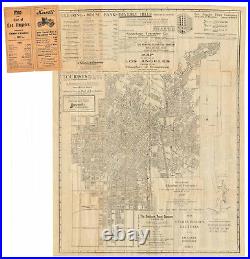

The Dawn of the Automobile Age. A fascinating 1907 city plan of Los Angeles demonstrating the small size of the city relative to its later expansion while hinting at its future sprawl. It was produced by the city’s Chamber of Commerce and printed by George Rice & Sons. The area roughly consistent with today’s downtown Los Angeles is displayed, from the old location of the Los Angeles Country Club and Rosedale Cemetery in the west to Boyle Heights and the vicinity of the future Los Angeles County – USC Medical Center on the east, and from Elysian Heights and the area near today’s Dodger Stadium in the north to the South Los Angeles or South Central area in the south. Roads, rail lines, essential buildings, parks, and cemeteries are labeled. Future urban development reshaped many areas, such as the just-mentioned Dodger Stadium and L. At the same time, other sites were repurposed, as with the Agricultural Park’s transformation towards the bottom left here into Exposition Park. At right is an area recently annexed by the city, the Harbor Gateway, discussed more fully below. Advertisements for banks and real estate companies surround the map and appear on the cover. An index of streets appears on the verso, corresponding to the grid surrounding the map. This map was printed at the height of a conflict over unionism in the city where the Chamber of Commerce played a central role. Organized labor had traditionally been weak in the city, and business-friendly policies partly drove the city’s economic growth in the late 19th century. The Chamber of Commerce, closely aligned with the. Advocated for making the city an’open shop’ town, which led to a showdown with the American Federation of Labor. The struggle became so intense that the city tried to restrict free speech to dampen the labor movement, and, in 1910, the. Though the open shop movement continued to face opposition from organized labor, particularly the Industrial Workers of the World, it was generally successful, weakening labor and strengthening business owners. The Chamber of Commerce also feuded with Collis P. Huntington (one of 19th century California’s “Big Four”) and his Southern Pacific Railway over the location of a new port for the city. The Southern Pacific naturally preferred expanding its existing facilities on Santa Monica Bay. At the same time, the Chamber and its allies at the. Instead supported a new port at San Pedro, fearing that Southern Pacific control of the port would allow it to pursue unfair business practices and expand its already considerable influence over the city (the dispute was one part of the’Free Harbor Fight’ throughout the West Coast). The territory annexed in 1906, shown here at right (known as the Harbor Gateway), was meant to provide a corridor of Los Angeles through nearby towns to reach San Pedro. Army Corps of Engineers helped settle the dispute by determining San Pedro as the better location for a modern port, and the future course of the Port of Los Angeles was set. However, their enmity was not absolute – the Chamber of Commerce and railways had collaborated in Southern California “boosterism” efforts in the late 19th century and, in the 1920s, found themselves on the same side (the losing side, ultimately) over Union Station in downtown Los Angeles; the railroads and Chamber instead favored a system of elevated electric rail lines. This map is listed among the holdings of twelve institutions worldwide in the OCLC (917201620). It appears to be an updated edition of a 1904 map published by the Chamber of Commerce and printed by Félix Violé (OCLC 82221221). George Rice & Sons 1896 – present? Are a Los Angeles-based lithographic printing company that is among the oldest continuously operating businesses in the city. In recent decades, the company has specialized in small runs of specialized prints. It is currently owned by Quebecor World.

